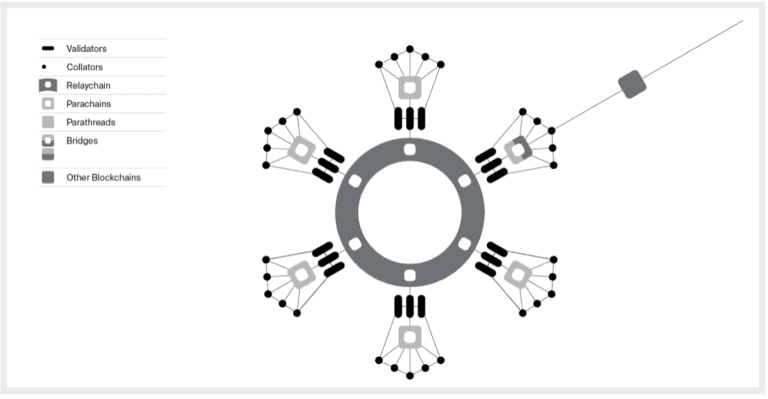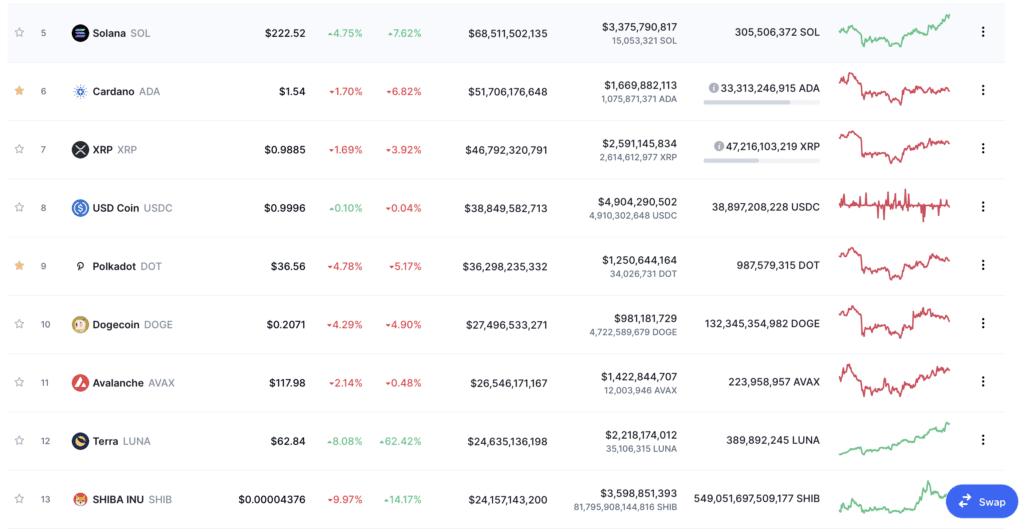What is Polkadot? aka DOT
Polkadot is a next-generation blockchain and layer-0 protocol that unifies and scales many specialised blockchains.
DOT (Polkadot) was created as part of a larger vision for a web that is equal, stable, and resilient by default (Web 3.0).
The Relay Chain
Polkadot is a project that aims to help citizens regain control of their digital information from powerful third parties by enabling a network where our data is protected from central authorities and internet monopolies.
This cryptocurrency enables new business models, services, organisations — and even whole communities and economies — to take shape and flourish in the future by providing the framework for a vibrant ecosystem of layer-1 blockchains.
In a nutshell, Polkadot aims to take blockchain technology’s groundbreaking promise to the next level by allowing various purpose-built blockchains to link within a scalable ecosystem and enabling safe cross-chain communication.
In other words, Polkadot is a “blockchain of blockchains,” which means it allows several different types of chains to function and communicate safely within the same ecosystem.

A bit of history
Dr. Wood co-founded the Web3 Foundation in 2017 with the aim of exploring and improving decentralised web technologies like Polkadot.
He co-founded Parity Technologies with former Ethereum security head Jutta Steiner, which has done the majority of the development work on Polkadot’s core technology as outlined in the whitepaper.
In 2019, Kusama, an unaudited canary network, was released as the first iteration of what would become the Polkadot codebase.
Kusama is an autonomous network in its own right that will continue to operate independently and grow according to the direction of its own decentralised culture, as well as a testing ground for Polkadot’s technology with real economic incentives.
Polkadot’s genesis block was introduced in May 2020 as a proof-of-authority (PoA) network with a single Sudo (super-user) account in charge of governance. Validators began entering the network and signalling their intention to engage in the consensus during this period.
In June 2020, the network rapidly developed into a proof-of-stake (PoS) network. The Sudo module was removed in July 2020, transferring the chain’s governance into the hands of token (DOT) holders, with the chain protected by a decentralised network of validators.
With the introduction of the Rococo para chain test net in December 2020, the rollout process for parachains — the advanced layer-1 blockchains that make Polkadot a multichain network — began.
Rococo is intended to test the para chain consensus mechanism, as well as community-built parachains and their experiences. In Spring 2021, Parachains are scheduled to be eligible on Kusama and Polkadot.
Polkadot design
Polkadot is a heterogeneous multi-chain network, which means it links several blockchains created for different purposes into a single ecosystem.
The Polkadot Relay Chain binds these different layer-1 blockchains, which are known as parachains because they handle transactions in parallel.
The Relay Chain
Polkadot’s core chain, the Relay Chain, was developed using Substrate, Parity’s architecture for creating custom blockchains.
Polkadot’s core, it’s in control of the network’s mutual stability, consensus, and cross-chain interoperability.
There are only a few transaction forms in the Relay Chain, but they provide ways to communicate with the governance process and engage in consensus.
It is intended to perform only the most basic functions, with the primary goal of securing and coordinating the whole structure.
The native token (DOT) is staked on the Relay Chain by all Polkadot validators, who validate transactions from the linked parachains.
Parachains
Polkadot parachains are separate layer-1 blockchains linked to the Relay Chain that operate in parallel.
Each parachain will have its own look, feel, accessibility, and governance. By connecting to DOT, parachains gain access to the entire network’s security, eliminating the need to build their own validator group and allowing them to exchange data other than tokens.
Polkadot was founded on the premise that one size does not suits everything when it comes to blockchain architecture.
Instead, to support numerous functions and use cases, all blockchains make tradeoffs. For instance, one chain can prioritise identity management while another prioritises file storage.
Since blockchains may have specialised architectures, they can have improved services while both increasing reliability and protection by eliminating unwanted code.
Parathreads
Parathreads are parachains that use a pay-as-you-go platform to link to Polkadot.
They lower the entry threshold for blockchains that do not need constant network access.
Depending on their needs and the availability of parachain slots on the Relay Chain, blockchains on Polkadot will switch between being parachains and parathreads.
Bridges
Bridges are a form of parachain that enables Polkadot chains and apps to connect to and interact with external networks including Ethereum and Bitcoin.
Consensus – Nominated Proof-of-Stake (NPoS)
Polkadot is a nominated proof-of-stake (NPoS) network with validators and nominators playing key roles in maintaining chain security.

Fishermen
Fishermen keep a close eye on the network and flag any unusual activities to validators. The fisherman position can be played by any complete node in the parachain.
Collators
Collators collect parachain transactions and generate proofs for the Relay Chain’s validators. They will also use cross-chain message passing to transmit and receive messages from other parachains (XCMP).
Nominators
Nominators often add to the network’s protection by staking their DOT on accurate validators, enabling them to join the active validator set. In addition, nominators are traditionally given a fraction of the validator’s staking prizes.
Validators
Validators stake the native token to protect the Relay Chain (DOT). They verify proofs from collators on the parachains, participate in agreement with other validators, and generate blocks on the Relay Chain if elected to the active set. They get staking prizes in exchange.
The DOT Token
The Polkadot network’s native token, DOT, serves three purposes:
- it can be staked for the network’s service and security
- it can be bonded to link a chain to Polkadot as a parachain
- it can be staked for the network’s service and security
DOT is inflationary, which means that, unlike Bitcoin, there is no limit on how many DOT can be produced.
The rate of inflation is not predetermined, it is expected to be 10% in the first year. The DOT is reserved for validator bonuses, with the balance going to the Treasury.
A Planck is the smallest unit of account in the ecosystem, equal to 0.0000000001 DOT.

The Polkadot “Bank”
The “Bank” or the treasury, earns funds by channelling some validator prizes (from minting) and a percentage of transaction fees, as well as cutting transaction fees (the fine paid by a validator who acts maliciously or incompetently).
The Polkadot Ecosystem
The Polkadot ecosystem has over 300 projects ranging from core technological technology to solutions for decentralised finance (DeFi), privacy-oriented data and digital identity platforms (often referred to as self-sovereign identity), social networking, IoT, gaming, robots, and supply chain logistics.
Many of these programmes are free and open source.
Polkadot’s most impactful implementations are yet to be imagined because it is a cutting-edge tool.
Services that support applications in which a user’s account and data are stored by encrypting them locally on their own devices rather than on a centralised server are among the projects currently being created.
This strategy provides users with total control of their own data in a user-friendly manner (so that even those who are unconcerned about privacy or data rights will benefit).
Community-owned networks that provide resources and share value in a decentralised manner through on-chain treasuries and governance could also emerge.
The future of Polkadot
Polkadot lays the groundwork for a modern open network as the underlying protocol for a thriving community of specialised, linked and sovereign blockchains.
As a result, DOT is built to allow a future in which digital technology is structured to defend our rights, trading networks and economies are more representative and competitive, decentralised financial services are more widely available, and we have a stable, open-source, peer-to-peer infrastructure for collaboration and connectivity.
Polkadot is an internet-native, borderless legal framework that prioritises human rights and autonomy over the authority of central institutions, powerful businesses, and despots, just as national constitutions do.
DOT is designed for a world of global decentralised coordination, allowing for the development of new markets in which all will flourish. Those that want to create new solutions on top of
Polkadot will ultimately decide. “You’ve heard the expression the pen is mightier than the blade,” said Polkadot creator Gavin Wood recently. “The keyboard, on the other hand, is quickly becoming more powerful than the ink.”
"The most serious in this field! professionalism and results to match! worth trying with confidence. Evolution FX!"
How Many Polkadot (DOT) Tokens Are There in Circulation?
Following the network’s redenomination from an original maximum availability of 10 million DOT tokens in August 2020, Polkadot now has an allowance of 1 billion DOT tokens.
The redenomination was solely for the purpose of eliminating the use of small decimals and simplifying equations. Although all balances were multiplied by a factor of one hundred, the distribution of DOT or the proportional share of investors was unchanged.
How Is the Polkadot Network Secured?
Where Can You Buy Polkadot (DOT)?
You can buy Polkadot (DOT) on the number one platform for cryptocurrency, Binance.
The actual price of Polkadot (DOT)
- Polkadot is reportedly trading at $36.56 USD, with a 24-hour volume of $1,250,644,134 (1.12.21)
- in the last 24 hours, Polkadot has lost 4,76% of its value
- live market cap of $36,298,235,332
- there are 987,579,315 DOT coins in circulation, and the maximum supply is unknown.

You can START NOW for FREE




